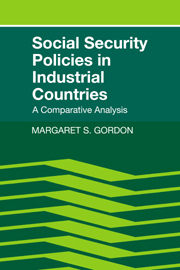Book contents
- Frontmatter
- Contents
- Preface
- Acknowledgments
- Abbreviations
- 1 Postwar developments
- 2 Differences in social security spending
- 3 National old-age pension programs: basic structure
- 4 Other major features of old-age pension programs
- 5 The age of retirement
- 6 Long-term invalidity programs
- 7 Industrial injuries programs
- 8 The role of employer pension plans
- 9 The economic impacts of pension programs
- 10 Health benefits
- 11 Unemployment compensation
- 12 Labor market policies
- 13 Family allowances and family policies
- 14 Public assistance and guaranteed income proposals
- 15 International linkages
- 16 Conclusions
- Appendix 1
- Appendix 2
- References
- Index
4 - Other major features of old-age pension programs
Published online by Cambridge University Press: 06 July 2010
- Frontmatter
- Contents
- Preface
- Acknowledgments
- Abbreviations
- 1 Postwar developments
- 2 Differences in social security spending
- 3 National old-age pension programs: basic structure
- 4 Other major features of old-age pension programs
- 5 The age of retirement
- 6 Long-term invalidity programs
- 7 Industrial injuries programs
- 8 The role of employer pension plans
- 9 The economic impacts of pension programs
- 10 Health benefits
- 11 Unemployment compensation
- 12 Labor market policies
- 13 Family allowances and family policies
- 14 Public assistance and guaranteed income proposals
- 15 International linkages
- 16 Conclusions
- Appendix 1
- Appendix 2
- References
- Index
Summary
Coverage
Unlike the early old-age pensions schemes, which were usually intended for wage earners, plus in some cases salaried employees, coverage under national old-age, survivors, and disability pension programs (OASD) now tends to be very broad, largely as a result of extension after World War II to all salaried employees, to the self-employed, and to farm workers. The Soviet Union and other Eastern European countries tended to lag behind other industrial countries in covering agricultural workers, but they are now largely covered.
Extensive coverage does not necessarily mean that issues relating to coverage have disappeared. The existence of separate systems for such groups as miners and seamen in European countries can create financial problems where employment of these groups is declining and the ratio of covered workers to retirees declines. The situation is particularly complex in France, where there are separate systems for agricultural, mining, and railroad workers, public utility employees, public employees, seamen, agricultural self-employed workers, and nonagricultural self-employed workers. Because large disparities developed in the financial status of these separate systems, there is now a requirement that systems with a surplus must transfer funds to systems with deficits. Retirees may in some instances be eligible for pensions from several of these schemes, but the combined amounts are often inadequate (Mitton, Willmott, and Willmott, 1983).
The women's movement has also given rise to coverage issues, such as coverage of housewives and continued coverage during periods of pregnancy and childrearing. We shall consider these later in this chapter.
- Type
- Chapter
- Information
- Social Security Policies in Industrial CountriesA Comparative Analysis, pp. 56 - 84Publisher: Cambridge University PressPrint publication year: 1989



